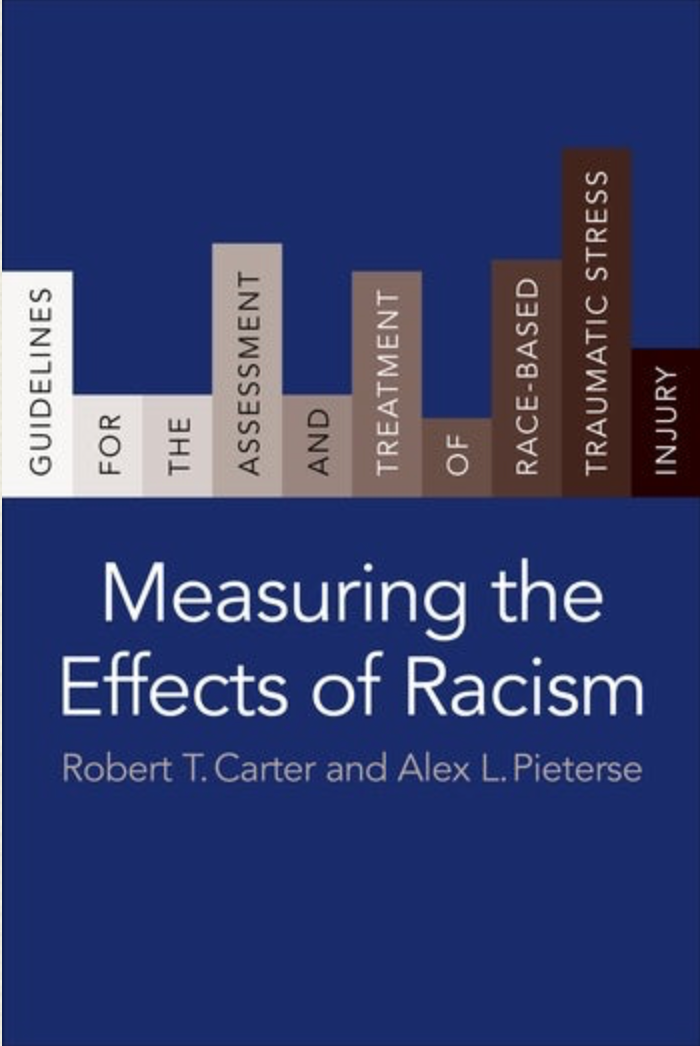Article
Measuring the Effects of Racism: Guidelines for the Assessment and Treatment of Race-Based Traumatic Stress Injury
Author(s):
This book provides key tools to help combat racism in the mental health profession.
BOOK REVIEW
by Robert T. Carver, PhD, and Alex L. Pieterse, PhD; Columbia University Press, 2020
423 pages • $35.00 (paperback)
Reviewed by H. Steven Moffic, MD, Jessica Isom, MD, MPH, and Rahn Bailey, MD
If you think that striving for cultural competence and humility makes you ready and able to address racism in your work, this book may tell you that is not quite so. If you think that we still need a scholarly way to classify and describe the harm from racism, this book provides it. If you think posttraumatic stress disorder is an inadequate and even misleading way to describe the ongoing trauma of systemic racism, because it is not truly post, then this book provides a different perspective. If you are unsure of how to consider racism in our clinical evaluations, a structured interview is provided in 1 of the Appendices. And if you need a way to measure racism, this book also provides that in another Appendix.
This well-researched book is written by 2 psychologists with a long history of scholarly work on racism. Beyond psychology per se, mental healthcare professionals of any discipline can benefit from this tour de force.
There are 3 main parts, though the Introduction should not be ignored. Part I, “What We Know About Racism and Stress,” lays out a new concept of trauma as applied to racism. Because race has been relatively ignored in prior studies of stress and trauma, despite the relatively greater experience of stress and trauma in those subjected to racism, the authors make a strong case that we need an appreciation of race-based traumatic stress (RBTS). The reader will note that RBTS eliminates the word “post” from the destructive trauma, as does a related conception from the psychologist Kevin Washington, called Persistent Enslavement Systemic Trauma, which refers back to the original systemic trauma of slavery.
Part II, “What We Need to Know about Racial Trauma,” seems to be the meat of the book. Here the authors offer an overview and critique of race and racism within mental health professional training, guidelines, and policy documents. Euphemistic considerations are discussed, including the erasure of race and racism within terms such as cultural difference, multiculturalism, and cultural diversity. While the authors acknowledge the overlap between PTSD and RBTS, they rely heavily on the literature base and carefully crafted empirical research to distinguish RBTS as a separate and valid phenomenon. The development of the Race Based Traumatic Stress Symptom Scale is detailed, including a focus on its construction and validity.
Part III covers “What to Do With What We Know: Practice Applications.” Racism at home, in everyday life, in mental healthcare, and in particular, in forensic assessments, is presented. The various types of interpersonal and institutional racial discrimination are associated with higher levels of negative mental health outcomes for many racial group members. It is pointed out, importantly, that clinicians, especially those from the white majority, typically believed that race did not matter, but at the same time feared that it did. Actual treatment is not covered in as much depth as the subtitle implies, though it recommends that RBTS treatment should be divided into 3 parts: containment, symptom reduction, and recovery. Recovery means that the clinician sometimes has to go beyond the traditional dyadic relationship to engage in advocacy, activism, or accessing resources for the patient. Group interventions with racially homogenous members can be particularly supportive and educational.
In conclusion, the self-knowledge of clinicians has to include their own experiences and identity as racial and cultural beings within a racialized society. At the same time, clinicians still have to remember that each patient is an individual who may or may not fit these general racial concepts. We—the public, patients, and ourselves—still face the challenge of a society with structural racism that produces an ongoing source of trauma and undue stress. We still have much work to do, and this volume provides a sound new conceptual base and some unique tools to do so successfully.
Dr Moffic is an award-winning psychiatrist who has specialized in the cultural and ethical aspects of psychiatry. A prolific writer and speaker, he received the one-time designation of being a Hero of Public Psychiatry from the Assembly of the American Psychiatric Association in 2002. He has recently been leading Tikkun Olam advocacy movements on climate instability, burnout, Islamophobia, and anti-Semitism for a better world. He serves on the Editorial Board of Psychiatric TimesTM. Dr Isom is a clinical instructor in psychiatry at Yale School of Medicine, psychiatrist, and racial health equity champion. Dr Bailey is assistant dean, Clinical Education, Charles Drew University School of Medicine; Chief Medical Officer, Kedren Community Health Systems, Los Angeles.
All 3 doctors are members of SPAR (Seven Psychiatrists Against Racism). To read more from them, see Dismantle Racism in Psychiatry & Society.
Newsletter
Receive trusted psychiatric news, expert analysis, and clinical insights — subscribe today to support your practice and your patients.







